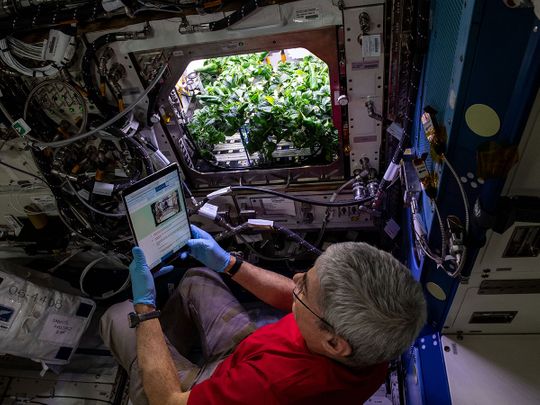
One small step for man, one giant leap for carne asada.
Astronauts aboard the International Space Station have successfully grown and harvested chiles in space, and this week they enjoyed their spoils for the first time. Megan McArthur, an American astronaut grinning ear to ear, said on Twitter that she added the peppers to fajita beef, rehydrated tomatoes and artichokes to create the "best space tacos yet."
Delicious tacos are always something to celebrate. But in this case, they are even more meaningful.
Astronauts eat mostly packaged foods, much of it freeze-dried to reduce its size and volume, with some fresh produce occasionally delivered to the station on routine supply missions. But a longer trip to Mars, which could take up to three years, would make receiving fresh groceries impossible, and delivery logistics would be difficult even on a shorter trip to the moon.
So growing food crops in space is seen as a crucial challenge to overcome, allowing astronauts to supplement their diets. Last year, NASA announced that lettuce grown in space was safe to eat and as nutritious as that grown on Earth. But chiles have been more difficult to grow; NASA described the experiment as "one of the most complex to date on station because of the long germination and growing times."
There are additional benefits to growing chiles. Astronauts who don't like the taste of their food may eat less, potentially leading to health issues. Adding some spice could improve morale and reduce fatigue with the limited culinary options available.
Because fluids flow to the head in a weightless environment, many astronauts become congested and crave spicy foods. Some have brought along hot sauce.
NASA researchers spent two years seeking out the perfect pepper to grow, evaluating more than two dozen options. They settled on the Hatch chile from Hatch, New Mexico, which has a rating of 2,000 to 4,000 Scoville Heat Units, roughly the level of Tabasco sauce. (Much like sparkling wine produced outside Champagne, France, the peppers grown on the space station are not technically Hatch peppers, since they were grown outside the Hatch Valley.)
Though astronauts have been growing plants in space for decades, cultivating edible food without the benefits of gravity and natural light has been difficult. Veggie, a chamber that has been used to grow lettuce and other plants on the space station since 2014, nurtures the plants in a porous ceramic clay instead of soil and uses wicks to guide water to the roots.
A NASA team planted 48 pepper seeds on Earth with a fertilizer specifically designed for peppers and sent them to the space station on a SpaceX cargo resupply mission. In July, astronauts began watering them and pollinating some of the flowers; a few of the plants developed fruit, which was harvested for the tacos, NASA said.








